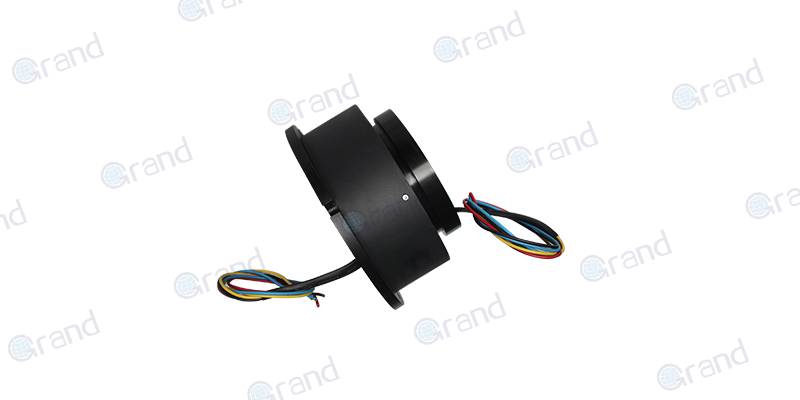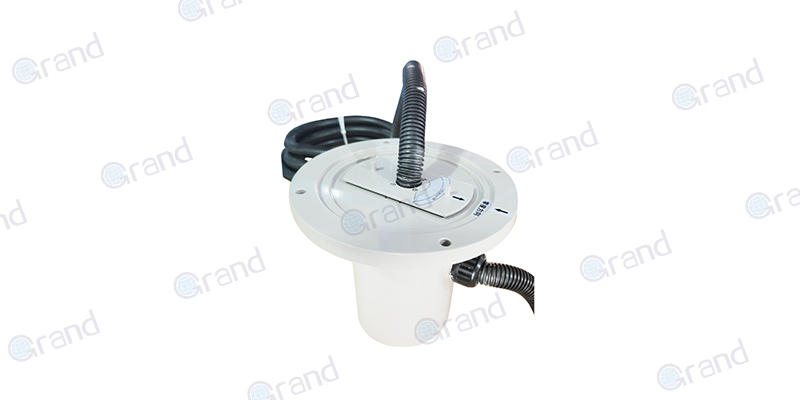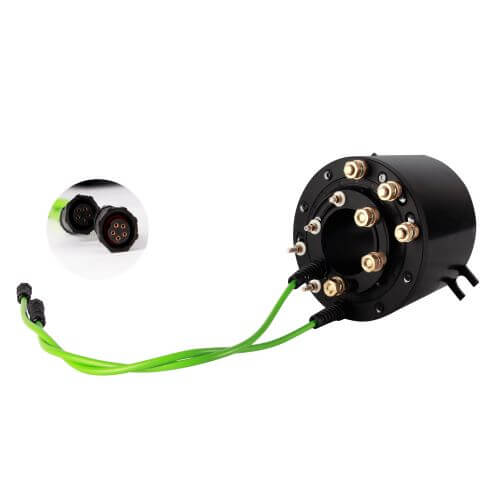Slip rings are electromechanical devices that enable the transmission of power and data between stationary and rotating components in machinery. They play a critical role in applications ranging from wind turbines to robotics, ensuring seamless operation without tangled cables. However, exposure to moisture, dust, and harsh environments poses significant challenges. Water ingress can lead to corrosion of internal contacts, signal degradation, or complete system failure, resulting in costly downtime and repairs. In industries like marine or offshore energy, where saltwater accelerates corrosion, or in food processing facilities subjected to high-pressure washdowns, unprotected slip rings quickly become liabilities.
Waterproof slip rings are essential for industries operating in demanding conditions. Marine and offshore sectors rely on them for underwater robotics, sonar systems, and mooring equipment to withstand submersion and saltwater exposure. Wind turbines utilize waterproof slip rings in pitch control systems to endure humidity and temperature fluctuations. In robotics and automation, waterproofing ensures reliability in wet or dusty environments, such as agricultural machinery or automated food packaging lines. Medical imaging devices like MRI machines also require sealed slip rings to maintain hygiene and prevent contamination. Even outdoor entertainment systems, such as rotating LED displays, benefit from waterproof designs to resist rain and humidity. Essentially, any application where moisture, dust, or extreme conditions threaten operational integrity demands a robust waterproof slip ring solution.
Understanding IP Ratings for Waterproof Slip Rings
What Are IP Ratings?
The Ingress Protection (IP) rating system, defined by the international standard IEC 60529, classifies the level of protection electrical enclosures (like slip rings) offer against solids and liquids. The IP code consists of two digits:
First digit (solid particle protection): Ranges from 0 (no protection) to 6 (dust-tight). For example, “5” indicates partial dust resistance, while “6” guarantees complete dust ingress prevention.
Second digit (liquid protection): Ranges from 0 (no protection) to 9K (high-pressure, high-temperature water jets). Common ratings include “4” (splash resistance), “7” (temporary submersion up to 1 meter for 30 minutes), and “8” (continuous submersion under specified conditions).
Common IP Ratings for Slip Rings
IP54: Protects against dust ingress (limited) and water splashes from any direction. Ideal for indoor industrial machinery exposed to occasional moisture.
IP65: Dust-tight and resistant to low-pressure water jets. Suitable for outdoor robotics or food processing equipment facing rain or washdowns.
IP67/IP68 waterproof slip ring marine certification: IP67 withstands temporary submersion (e.g., marine equipment in shallow water), while IP68 guarantees prolonged underwater operation (e.g., offshore drilling systems). Always verify depth and duration limits specified by the manufacturer.
How to Interpret IP Ratings for Your Application
Match the IP rating to your operating environment. For instance, a slip ring in a coastal wind turbine requires at least IP67 to handle humidity and salt spray, while a medical device in a sterile lab may only need IP54 for basic splash resistance.
Limitations of IP Ratings
While IP ratings are crucial, they don’t account for:
Temperature extremes: Submersion in icy water or high-heat environments may degrade seals.
Chemical exposure: Acids, oils, or solvents can compromise sealing materials not covered by IP testing.
Mechanical stress: Vibration or pressure fluctuations (e.g., deep-sea applications) may exceed IP-rated conditions.
Always cross-reference IP ratings with additional certifications (e.g., NEMA, MIL-STD) and discuss real-world operating conditions with manufacturers to ensure long-term reliability.

Key Sealing Methods for Waterproof Slip Rings
Mechanical Seals
Mechanical seals are physical barriers designed to prevent water, dust, and contaminants from entering the slip ring assembly. Common types include:
O-rings: Elastic rings made of silicone, Viton®, or nitrile rubber, compressed between surfaces to create a watertight seal. Silicone offers flexibility in extreme temperatures, while Viton® excels in chemical resistance.
Lip seals: Dynamic seals with a flexible lip that maintains contact with rotating shafts. Ideal for high-speed applications but prone to wear over time.
Labyrinth seals: Non-contact seals with a tortuous path that blocks contaminants through air pressure and gravity. Low friction but less effective in static or submerged environments.
Pros: Durable, customizable for specific speeds/temperatures, and easy to replace.
Cons: Friction from contact seals (e.g., O-rings) can generate heat and wear, reducing lifespan in high-speed systems.
Encapsulation and Potting
This method involves filling the slip ring’s internal cavity with epoxy resins or polyurethane to immobilize and protect components from moisture, humidity, and condensation.
Epoxy resins: Provide rigid, chemical-resistant protection for harsh environments like marine or industrial settings.
Polyurethane: Flexible and shock-absorbent, suitable for applications with vibration (e.g., wind turbines).
Pros: Complete protection against environmental ingress, eliminates internal condensation, and enhances structural integrity.
Cons: Irreversible process; repairs require destroying the encapsulation. Thermal expansion mismatches can stress components.
Modular Design
Modular slip rings compartmentalize channels into individually sealed units. For example, a 12-channel slip ring might have three sealed compartments of four channels each.
Maintenance-friendly: Failed modules can be replaced without dismantling the entire system.
Fully sealed units: Prioritize maximum protection by eliminating internal access points, ideal for submersible or high-pressure applications.
Pros: Balances maintenance flexibility with robust protection. Reduces downtime in critical systems like offshore robotics.
Cons: Increased complexity and cost compared to single-sealed designs.
Specialized Coatings
Advanced coatings add an extra layer of protection to slip ring surfaces:
Nano-coatings: Hydrophobic materials (e.g., fluoropolymers) create water-repellent surfaces, preventing droplet formation and corrosion.
Anti-corrosion coatings: Zinc-nickel plating or ceramic coatings protect marine slip rings from saltwater degradation.
Pros: Lightweight, minimal impact on slip ring dimensions, and compatible with other sealing methods.
Cons: Coatings alone are insufficient for submersion; typically used alongside mechanical seals or encapsulation.
Real-World Testing for Waterproof Slip Rings
Laboratory Testing Standards
To ensure slip rings meet waterproofing claims, manufacturers rely on rigorous lab tests:
IEC 60529: The benchmark for IP rating validation. Tests involve exposing slip rings to dust chambers, water jets, or submersion tanks to verify resistance levels (e.g., IP67 requires 30 minutes underwater at 1-meter depth).
Salt Spray Testing (ASTM B117): Simulates corrosive marine or coastal environments by misting slip rings with saltwater for hundreds of hours. Checks for corrosion on contacts, seals, and coatings.
Thermal Cycling: Subjects slip rings to extreme temperature fluctuations (-40°C to +85°C) to test seal integrity and material expansion/contraction. Critical for outdoor or aerospace applications.
Field Testing Scenarios
Lab tests are supplemented with real-world trials:
Submersion Tests: Slip rings for underwater robotics or tidal energy systems are deployed in saltwater for months to monitor long-term performance.
High-Pressure Washdowns: In food processing plants, slip rings undergo daily high-pressure, high-temperature cleaning to validate resistance to steam and chemicals.
Vibration/Shock Resistance: Industrial robots or military equipment test slip rings under repetitive motion or sudden impacts to ensure seals remain intact.
How to Validate Manufacturer Claims
Request Certificates: Reputable suppliers provide IEC 60529 or ASTM B117 compliance reports.
Third-Party Verification: Independent labs like UL or TÜV offer unbiased testing certifications.
Case Studies & References: Ask for proof of performance in similar applications (e.g., “Used in offshore wind farms since 2020”).

Applications of Waterproof Slip Rings
Waterproof slip rings are critical components in industries where exposure to moisture, dust, or extreme conditions threatens system reliability. Below is a detailed breakdown of their key applications:
Marine & Offshore
Applications:
Underwater Robotics: Remotely Operated Vehicles (ROVs) and Autonomous Underwater Vehicles (AUVs) rely on waterproof slip rings (e.g., IP68-rated) to transmit power and data while exploring ocean depths, inspecting pipelines, or repairing offshore infrastructure.
Mooring Systems: Dynamic positioning systems and rotating buoys use slip rings to manage power and signal transmission in tidal zones, where saltwater corrosion and constant submersion demand robust sealing (e.g., stainless steel housings, Viton® seals).
Sonar and Radar Systems: Shipborne equipment requires slip rings resistant to salt spray and humidity to ensure uninterrupted communication and navigation.
Challenges: Saltwater corrosion, high pressure, and biofouling.
Solutions: IP68/IP69K ratings, anti-corrosion coatings (e.g., zinc-nickel plating), and modular designs for easy maintenance.
Wind Energy
Applications:
Pitch Control Systems: Slip rings in wind turbine nacelles adjust blade angles to optimize energy output and prevent damage during storms. They endure humidity, temperature swings, and airborne debris.
Yaw Systems: Waterproof slip rings enable communication between stationary control systems and rotating turbine heads, even in icy or rainy conditions.
Challenges: Condensation inside nacelles, vibration, and long-term exposure to UV radiation.
Solutions: IP67-rated encapsulation, thermal-resistant materials, and vibration-dampening designs.
Industrial Automation
Applications:
Food and Beverage Processing: Hygienic slip rings (IP69K-rated) withstand daily high-pressure, high-temperature washdowns in bottling lines, mixers, and packaging machines. Materials like FDA-compliant PTFE ensure chemical resistance.
Agricultural Robotics: Harvesters and drones use waterproof slip rings to operate in muddy fields or dusty grain silos, transmitting sensor data and powering actuators.
Automated Washdown Systems: Slip rings in cleaning robots or conveyor systems resist steam, detergents, and particulate ingress.
Challenges: Chemical exposure, abrasive particulates, and frequent sterilization.
Solutions: Non-porous sealing (e.g., epoxy potting), stainless steel exteriors, and anti-abrasion coatings.
Medical Imaging
Applications:
CT Scanners and MRI Machines: Slip rings in rotating gantries transmit high-resolution imaging data without interference from disinfectants or condensation.
Surgical Robotics: Waterproof designs ensure sterility in operating rooms, with materials resistant to alcohol-based cleaners.
Challenges: Sterile environments, electromagnetic interference (EMI), and precision requirements.
Solutions: IP54+/IP65 ratings, non-conductive coatings, and low-noise signal transmission.
Emerging and Niche Applications
Renewable Energy:
Wave and tidal power generators use submersible slip rings to handle saltwater and mechanical stress.
Solar tracking systems employ waterproof slip rings to rotate panels in rainy or dusty climates.
Outdoor Entertainment:
Rotating LED screens and amusement park rides (e.g., Ferris wheels) rely on slip rings resistant to rain, humidity, and temperature extremes.
Defense and Aerospace:
Military drones and radar systems use ruggedized slip rings for desert, Arctic, or maritime operations.
Why These Applications Demand Waterproofing
Preventing Downtime: A single failure in a wind turbine or underwater robot can lead to costly repairs and operational halts.
Safety Compliance: Medical and food-grade applications require adherence to strict hygiene and safety standards (e.g., FDA, ISO 13485).
Longevity: Corrosion-resistant materials and advanced sealing extend equipment lifespan in corrosive or high-wear environments.
Waterproof slip rings are not a one-size-fits-all solution. Each industry’s unique challenges—whether saltwater submersion, high-pressure washdowns, or sterile environments—dictate specific IP ratings, materials (e.g., marine-grade aluminum, medical plastics), and sealing methods. Partnering with manufacturers that understand these nuances ensures reliability, compliance, and cost-efficiency.

Choosing the Right Waterproof Slip Ring
Selecting the ideal waterproof slip ring requires balancing environmental demands, performance needs, and budget. Below is a detailed guide to making informed decisions:
Key Questions to Ask
What Is the Operating Environment?
Liquid Exposure:
Freshwater: IP67 may suffice for temporary submersion (e.g., irrigation systems).
Saltwater: Opt for IP68 with anti-corrosion coatings (e.g., marine-grade stainless steel, nickel plating).
Chemicals/Oils: Use chemically resistant seals (Viton® or PTFE) and encapsulation to protect against solvents or acids.
Temperature Extremes:
High-heat environments (e.g., foundries) require silicone seals (-60°C to +230°C tolerance).
Sub-zero conditions (e.g., Arctic robotics) need materials resistant to brittleness (e.g., specialized polyurethane).
Particulate Contamination:
Dusty environments (e.g., construction sites) demand IP6X-rated dust-tight designs.
Dynamic vs. Static Sealing Requirements:
Dynamic Seals: Required for rotating components (e.g., wind turbine yaw systems). Lip seals or labyrinth seals reduce friction while maintaining contact.
Static Seals: Used in stationary joints (e.g., encapsulated control units). O-rings or gaskets provide cost-effective, long-term protection.
Trade-Offs: Cost vs. Longevity vs. Performance:
Budget-Conscious: IP54/IP65 slip rings work for light industrial use but may require frequent seal replacements.
High-Performance: IP68/IP69K units with epoxy potting or modular designs offer longevity in extreme conditions but cost 2–3x more.
Balanced Approach: Prioritize critical components (e.g., submersion-rated seals for marine applications) while using standard seals elsewhere.
Maintenance Tips
Inspecting Seals for Wear:
Visual Checks: Look for cracks, deformation, or discoloration in O-rings and lip seals.
Performance Tests: Monitor for increased electrical noise or signal loss, which may indicate seal degradation.
Environmental Stress Signs: Check for corrosion (saltwater) or swelling (chemical exposure) on housings.
Cleaning Protocols for Harsh Environments:
Marine/Offshore: Rinse with freshwater after saltwater exposure to prevent corrosion. Use soft brushes to avoid damaging coatings.
Food Processing: Clean with pH-neutral detergents; avoid abrasive tools that could scratch FDA-compliant seals.
Industrial Dust: Use compressed air or vacuum systems to remove particulates from vents or seals.
Preventive Measures:
Replace seals proactively (e.g., every 12–24 months in high-wear applications).
Lubricate dynamic seals with silicone-based grease to reduce friction and extend lifespan.
Store spare slip rings in climate-controlled areas to prevent seal degradation.
Pro Tips for Procurement
Demand Customization: Many manufacturers offer hybrid designs (e.g., combining encapsulation for electronics with mechanical seals for rotating parts).
Verify Compatibility: Ensure seals and coatings align with other system materials (e.g., avoid galvanic corrosion between aluminum housings and steel bolts).
Document Everything: Keep records of IP ratings, test certificates, and maintenance schedules for compliance audits.
The “right” waterproof slip ring hinges on aligning IP ratings, sealing methods, and maintenance plans with your operational reality. For example, a food processing plant might prioritize easy-to-clean IP69K units despite higher costs, while a marine robotics startup could favor modular designs for quick repairs at sea. Always consult manufacturers to validate specs against your unique use case.
FAQs About Waterproof Slip Rings
Can a slip ring be both waterproof and high-speed?
Yes. Manufacturers offer specially designed slip rings that combine full environmental sealing (e.g. IP67/IP68) with high rotational speeds. To achieve this, they typically employ:
Advanced sealing systems (labyrinth seals, specialized O-rings or lip seals) to keep out moisture and contaminants.
High-precision bearings rated for elevated RPMs and low run-out, which minimize heat and wear.
Balanced rotor assemblies to reduce vibration at speed.
Depending on the design, waterproof high-speed rings can reliably run from several hundred up to a few thousand RPM; beyond that, sealing life and temperature rise become limiting factors.
How long do waterproof seals typically last?
Seal life depends on several factors—materials, operating conditions, and maintenance—but rough guidelines are:
Elastomer/EPDM or silicone O-rings: Typically rated for 1–3 years of continuous operation, or on the order of 10⁶–10⁷ revolutions, before hardness changes and extrusion set begin to compromise sealing.
Static seals (no relative motion) often far outlast dynamic seals—up to 10 years in benign environments.
Reinforced or PTFE-based dynamic seals can extend service life to 5+ years under moderate speeds.
Regular inspection and periodic lubrication (as recommended by the manufacturer) can help maximize seal longevity.
Can I retrofit a standard slip ring to be waterproof?
In most cases, no. Standard (non-sealed) slip rings are not built with the tolerance, clearances, or housing provisions needed for true ingress protection. While you might add external boots or enclosures for splash resistance:
Such aftermarket fixes rarely achieve IP67/IP68, especially under immersion.
Heat dissipation can be compromised if you over-encapsulate the unit.
Warranty and performance guarantees are typically voided once you modify the original assembly.
Recommendation: Use a purpose-built waterproof slip ring whose design, materials, and testing are certified for the environment you need.
What happens if the IP rating is exceeded?
Exceeding the declared IP rating (e.g. deeper immersion or higher water pressure than specified) can lead to:
Ingress of liquid or dust into the contact area.
Corrosion of metal conductors and bearings.
Electrical shorts or intermittent signal dropouts.
Accelerated wear of internal components from contamination.
Catastrophic failure, potentially posing safety hazards.
Always select a slip ring with an IP rating equal to or higher than the most severe conditions it will face in service.
See What We Can Do

